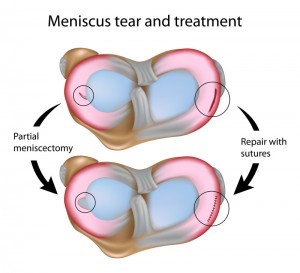Meniscectomy and Meniscus Repair
What is a Meniscectomy and Meniscus Repair?
 These procedures involve surgical removal or repair of the C Band located inside of the cartilage of your knee joint. This is called the meniscus. The meniscus serves as a buffer between the bones which connect at your knee joint. It also absorbs shock and helps to lubricate your joint.
These procedures involve surgical removal or repair of the C Band located inside of the cartilage of your knee joint. This is called the meniscus. The meniscus serves as a buffer between the bones which connect at your knee joint. It also absorbs shock and helps to lubricate your joint.
The meniscus limits the extension and rotation of your knee joint as well. If you Hyper flex or twist your joints it can cause your meniscus to tear. The location of your torn meniscus and the type of tear that you have will determine how much of your meniscus has to be removed. Very rarely does a Los Angeles knee specialist remove the entire meniscus because this will only result in increased instability in your knee.
Who is at risk for meniscus injuries?
Many of these injuries are sports related. Even though proper techniques while playing sports and exercising is emphasized, some tears are not preventable. If you hear a pop and afterward feel joint tenderness and knee pain it might be a tear.
Degenerative meniscal tears commonly occur as well. These are a by-product of arthritis and usually lead to pain that comes on without a traumatic event.
Who needs this procedure?
The meniscectomy procedure is reserved for those with a tear and significant ongoing pain that has not responded to conservative treatments. The meniscal repair procedure is more complicated. The normal meniscus only has a blood supply in the outer third.
Therefore, the meniscal tear needs to have occurred in the outer third in order to repair it and expect it to heal.
What happens during the procedure?
Arthroscopic surgery is now the standard procedure for this surgery. It offers less pain and a faster recovery. However based on the location of your injury and the type of injury it may prove difficult. Your Los Angeles orthopedic surgeon will make a small incision in the knee through which he will insert the viewing scope which contains a small camera. This camera will be linked to the video screen in the surgical room so that the surgeon can view the inside of your knee. He will inject fluid into your knee that expands your joints – this enables better viewing of the cartilage and the structures inside of your knee.
If there is a tear along the inner curve of your meniscus the Beverly Hills orthopedic surgeon will remove the damaged area. If there is a tear on the outer rim it can possibly be repaired with stitches, as presumably it has a blood supply for adequate healing. With either procedure fragments of your cartilage will be removed.
When the surgery is done the arthroscope will be removed and the incision will be closed with sutures. In a conventional process once you have been given general anesthesia, the affected area will be given a nerve inhibitor to minimize the pain.
What is the rehabilitation?
You should allow 2 to 8 weeks for recovery, potentially longer after a meniscal repair. The primary focus of your rehabilitation is to control your pain into restore normal function to your knee. Your rehabilitation program is dependent upon the severity of your surgical procedure. At the beginning pain can be controlled with heat and cold. You can integrate this into your physical therapy and use compressive devices.
Once you have regained your ability to walk and use your knee your next goal will be to restore the strength in your knee and the motion. You will have to undergo range of motion exercises to help you. Once this is done you can progress based on the recommendations of your surgeon to increase your strength in the joints and areas around the affected area. Strengthening your muscles and your joint is critical but so is increasing the flexibility of your muscle groups.
References:
http://orthocarefl.com/?page_id=785
http://www.arthroscopyjournal.org/article/S0749-8063(11)00412-9/abstract
